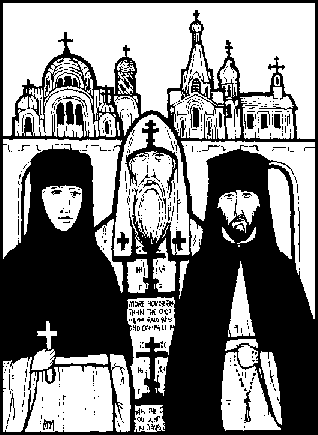This Sunday the Orthodox Church commemorates Saint Gregory Palamas during Great Lent, and it might seem like a difficult example to draw a lesson from. If you are wondering how to make this Sunday relevant, consider teaching about the
subject of monasticism since the Saint spent several years living and praying within a small cave outside of Thessaloniki, Greece. It can be a great opportunity to introduce to our youth the actual daily routine of an Orthodox monk or nun.
Even the fact that in our tradition, we have monks and nuns!In Greek "monos" literally means alone. Hence the word "monastic" - one who lives alone
Brief vocab for the lesson with a printable worksheet: The Talanto - a long narrow piece of wood struck with a pallet by designated monks/nuns in the monastery as a call to prayer for the others to attend Church. This tradition comes from the great Prophet Noah, who hit the ark to call the animals to enter inside.
The Hours - or otherwise known as the daily rule of prayer - praying the hours happens six times a day, at symbolic hours. 7 am (first hour, sunrise), 9 am (third hour, time of the coming of the Holy Spirit at Pentecost), 12 noon (sixth hour, our Lord's sacrifice began at Golgotha), 3 pm (ninth hour, our Lord's sacrifice on the Cross ended as He gave up His spirit to the Heavenly Father), 6 pm (Vespers - setting of the sun), 9 pm (Compline - before sleep), 12 midnight ( in the silent darkness the soul rises for prayer)
Komboskini - or prayer rope, in several sizes. The most common is 33 knots for 33 years of Christ's life. It is made by the hands of the monks/nuns who recite the Jesus prayer while making each knot, sealing within it the name of Christ. After it is complete, the prayer ropes are used as tools to continue praying for others and the world, often never leaving the fingers of praying monastics!
 Tonsure -
Tonsure - this is the rite of initiation into the monastic state or the official blessing and becoming of a monk or nun in the Orthodox Church by a Bishop or Archimandrite. There are three levels:
Rassophore,
Stavrophore, and the
Great Schema. The hair is cut as an offering of the person to God along with their whole life and their self will. Afterward the hair, even a beard, is never cut again. Vows of chastity, obedience and poverty are made with a commitment to strive within the monastery community of fellow brothers and sisters.
Ascetic - one who lives apart from the world to dedicate their life fully to God, sometimes in a cave or the desert. It is a very difficult life, with very little food, maybe dried bread or plants. Usually little clothing, a rock for a pillow and no dvd's, iphones or McDonalds!
Gerontissa, Geronda, Abbess, or Abbot - This is the spiritual mother or father assigned with the task of guiding and confessing the others monks and nuns to their salvation in Christ. Visitors to the monastery often bow and offer a kiss to their hand to take their blessing.
Novice - This is the title used for a beginner or interested person in becoming a monk or nun. Often this candidate will live within the monastery for several years as a trial to be certain before being tonsured.
Trapeza - This is the dining hall where meals are shared all together. Fasting from meat is year round, and often spiritual food is offered simultaneously through reading or a small sermon. Sometimes, water is drunk only second to food when a small bell is rung, reinforcing the discipline of taming self will through obedience and gratefulness to God.
Diakonima – each monk or nun has specific work to complete that is assigned to them. Everyone works for the love of Christ and contributes to the community. Some cook, others garden, while another sews, and chants etc.
A monk or nun leaves the world to prayer for the world!Explain that there are Orthodox monasteries around the world, and include a short description or slide show of photos from
Mount Athos if you would like. Also share the location of an Orthodox Monastery near you.
From personal experience, there is no greater impact on our youth than an actual visit to an Orthodox monastery first hand! Please consider arranging for a group trip from your parish, and expose this way of life to our young people. A few children's books on the subject:
http://www.amazon.com/Abbot-As-Told-Josie-Cat/dp/188821225X http://www.amazon.com/Song-Talanton-Claire-Brandenburg/dp/188821290X

 Remembering back to last year, the kids really enjoyed our Lazarus Saturday activity so I'm posting it again with a few talking points to build into your lesson early enough, along with our favorite photos.
Remembering back to last year, the kids really enjoyed our Lazarus Saturday activity so I'm posting it again with a few talking points to build into your lesson early enough, along with our favorite photos.


